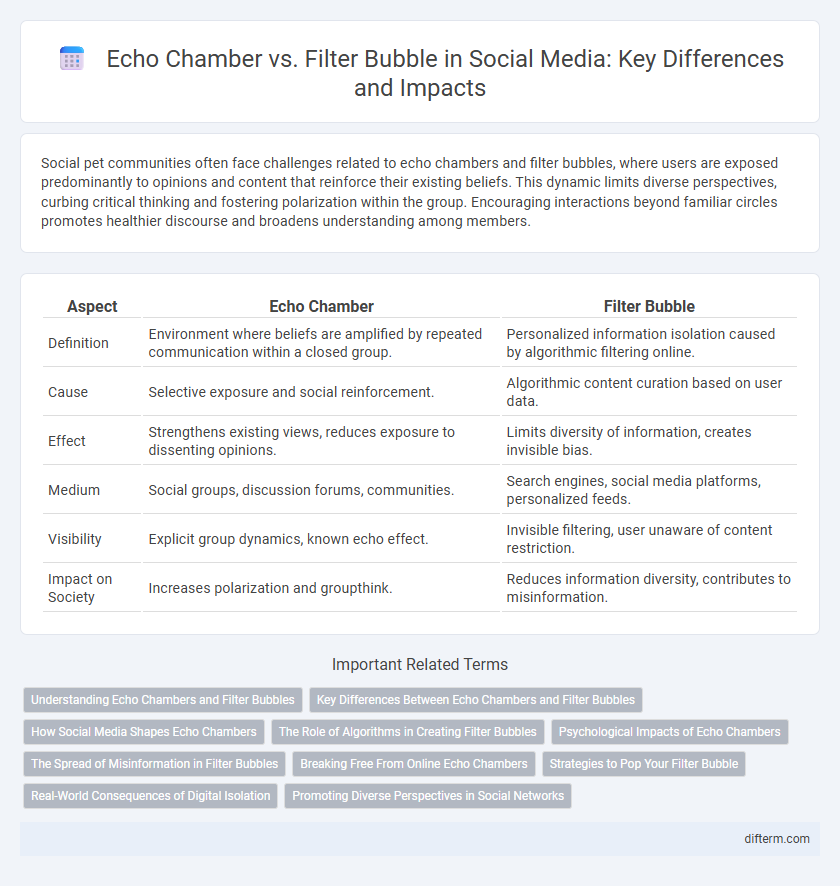Social pet communities often face challenges related to echo chambers and filter bubbles, where users are exposed predominantly to opinions and content that reinforce their existing beliefs. This dynamic limits diverse perspectives, curbing critical thinking and fostering polarization within the group. Encouraging interactions beyond familiar circles promotes healthier discourse and broadens understanding among members.
Table of Comparison
| Aspect | Echo Chamber | Filter Bubble |
|---|---|---|
| Definition | Environment where beliefs are amplified by repeated communication within a closed group. | Personalized information isolation caused by algorithmic filtering online. |
| Cause | Selective exposure and social reinforcement. | Algorithmic content curation based on user data. |
| Effect | Strengthens existing views, reduces exposure to dissenting opinions. | Limits diversity of information, creates invisible bias. |
| Medium | Social groups, discussion forums, communities. | Search engines, social media platforms, personalized feeds. |
| Visibility | Explicit group dynamics, known echo effect. | Invisible filtering, user unaware of content restriction. |
| Impact on Society | Increases polarization and groupthink. | Reduces information diversity, contributes to misinformation. |
Understanding Echo Chambers and Filter Bubbles
Echo chambers occur when individuals are exposed predominantly to information that reinforces their existing beliefs, limiting exposure to diverse perspectives. Filter bubbles result from algorithm-driven personalization on social media and search engines, which curate content based on users' preferences and behavior, further isolating them from differing opinions. Both phenomena contribute to social polarization by creating environments where critical engagement with contrasting ideas is minimized.
Key Differences Between Echo Chambers and Filter Bubbles
Echo chambers amplify beliefs by repetitively exposing individuals to identical viewpoints within a closed social environment, reinforcing existing opinions without challenge. Filter bubbles, generated by algorithmic personalization on online platforms, selectively present information tailored to users' preferences, limiting exposure to diverse perspectives. The key distinction lies in echo chambers being socially constructed through group interaction, whereas filter bubbles result from automated content curation based on user data and behavior.
How Social Media Shapes Echo Chambers
Social media algorithms prioritize content aligned with users' interests, reinforcing echo chambers by exposing individuals predominantly to like-minded perspectives. This selective exposure intensifies confirmation bias, limiting diverse viewpoints and polarizing opinions within digital communities. Consequently, social platforms inadvertently cultivate environments where misinformation and extreme views can thrive unchallenged.
The Role of Algorithms in Creating Filter Bubbles
Algorithms personalize online experiences by analyzing user behavior to deliver tailored content, unintentionally reinforcing filter bubbles that limit exposure to diverse perspectives. These algorithm-driven echo chambers prioritize engagement metrics, often promoting similar viewpoints and reducing encounters with opposing ideas. As a result, users become confined to information silos, amplifying polarization and hindering critical thinking in digital social interactions.
Psychological Impacts of Echo Chambers
Echo chambers intensify confirmation bias by repeatedly exposing individuals to homogeneous viewpoints, reinforcing existing beliefs and reducing critical thinking. This psychological impact fosters increased polarization and emotional entrenchment, impairing open-mindedness and empathy towards opposing perspectives. Persistent exposure within echo chambers can also elevate anxiety and stress by amplifying fear-based narratives and social division.
The Spread of Misinformation in Filter Bubbles
Filter bubbles amplify the spread of misinformation by limiting exposure to diverse viewpoints and reinforcing existing beliefs through algorithm-driven content curation. Social media platforms utilize personalized algorithms that prioritize content aligned with users' preferences, creating isolated environments where false information circulates unchecked. This selective exposure hinders critical evaluation and perpetuates false narratives, intensifying the challenges of combating misinformation in digital spaces.
Breaking Free From Online Echo Chambers
Breaking free from online echo chambers requires actively seeking diverse perspectives beyond algorithm-driven filter bubbles. Engaging with varied news sources, participating in cross-ideological dialogues, and utilizing digital literacy tools help dismantle cognitive biases reinforced by personalized content feeds. This approach fosters critical thinking and promotes a more balanced understanding of social issues.
Strategies to Pop Your Filter Bubble
Engaging in diverse social networks and actively seeking out conflicting viewpoints disrupts the echo chamber effect, helping to pop your filter bubble. Utilizing multiple news sources and adjusting algorithmic settings on social media platforms broadens information exposure and reduces content personalization biases. Participating in offline discussions and embracing cognitive flexibility further enhance critical thinking by challenging existing beliefs and promoting balanced perspectives.
Real-World Consequences of Digital Isolation
Echo chambers and filter bubbles intensify digital isolation by limiting exposure to diverse perspectives, reinforcing existing beliefs and increasing polarization in society. This digital segregation fosters misinformation, decreases critical thinking, and undermines democratic discourse by creating echoing silos of like-minded individuals. Studies reveal that such isolation correlates with decreased social cohesion and amplified political extremism.
Promoting Diverse Perspectives in Social Networks
Promoting diverse perspectives in social networks counters the effects of echo chambers and filter bubbles by exposing users to varied viewpoints and information sources. Algorithms that prioritize content diversity increase critical thinking and reduce polarization by broadening users' information horizons. Integrating cross-cutting discussions and diverse content helps foster understanding, empathy, and social cohesion online.
echo chamber vs filter bubble Infographic

 difterm.com
difterm.com